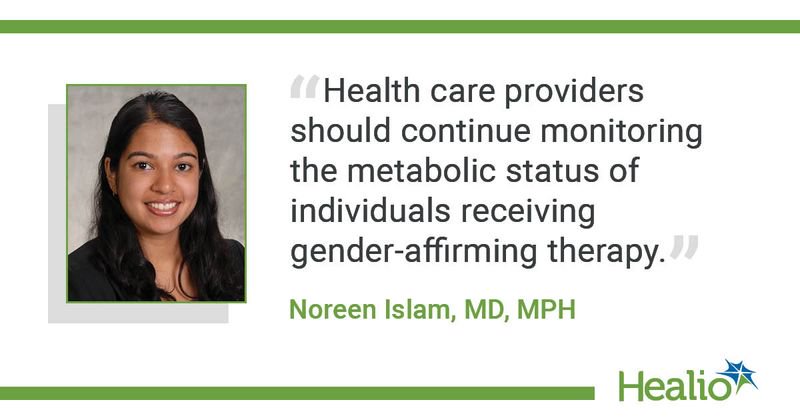No association between gender-affirming hormone therapy, diabetes risk
Click Here to Manage Email Alerts
Transgender people prescribed gender-affirming hormone therapy were no more likely to develop type 2 diabetes compared with cisgender adults, according to an analysis of electronic health records data.
“Our study findings provide some reassurance that gender-affirming therapy does not increase the risk of type 2 diabetes, but our analysis was not designed to evaluate more subtle subclinical changes,” Noreen Islam, MD, MPH, a fellow in the division of pediatric endocrinology at Emory University School of Medicine, said in a press release. “For this reason, health care providers should continue monitoring the metabolic status of individuals receiving gender-affirming therapy.”

Islam and colleagues analyzed EHR data from 2,869 transgender or transfeminine women matched by age, race, calendar year and site with 28,300 cisgender women and 28,258 cisgender men, as well as 2,133 transgender or transmasculine men matched with 20,997 cisgender women and 20,964 cisgender men. All patients were enrolled in one of three Kaiser Permanente health systems in Northern California, Southern California and Georgia, and were followed from 2006 to 2014, with follow-up extended through 2016. Researchers used Cox proportional hazard and logistic regression models, controlled for BMI, to assess data on type 2 diabetes incidence and prevalence.
“Both male and female cisgender reference groups were used because hormone serum concentrations among transgender persons can range from normal physiologic male to normal physiologic female levels, depending on the mode of delivery and dosage of hormone therapy, as well as individual characteristics,” the researchers wrote.
Researchers found prevalent and incident type 2 diabetes were more common among transgender women compared with cisgender women, with an OR of 1.3 (95% CI, 1.1-1.5) and an HR of 1.4 (95% CI, 1.1-1.8), respectively. There were no between-group differences in diabetes prevalence or incidence across the remaining comparison groups, both overall and among transgender and gender-diverse people with evidence of gender-affirming HT use.
“Although more research is needed, there is little evidence that type 2 diabetes occurrence in either transgender women or transgender men is attributable to gender-affirming hormone therapy, at least in the short term,” Islam said in the release.
The researchers noted that the analysis lacked data on other type 2 diabetes risk factors, including family history, socioeconomic status, adverse childhood experiences and information on gender minority stress, which has been associated with a wide range of adverse clinical outcomes.
“Taking into consideration the apparent absence of the association between gender-affirming HT receipt and type 2 diabetes incidence in our study, additional research should focus on the hypothesized effect of gender minority stress and its interaction with lifestyle related metabolic risk factors among transgender people,” the researchers wrote.
For more information:
Noreen Islam, MD, MPH, can be reached at noreen.islam@emory.edu.


